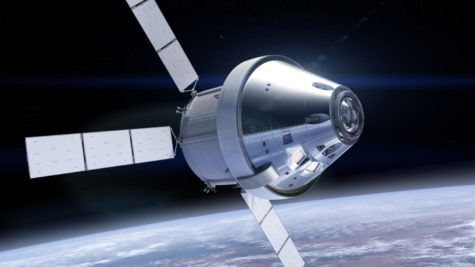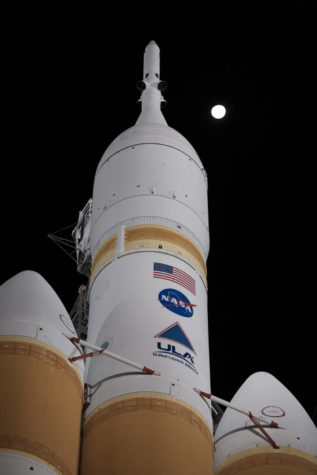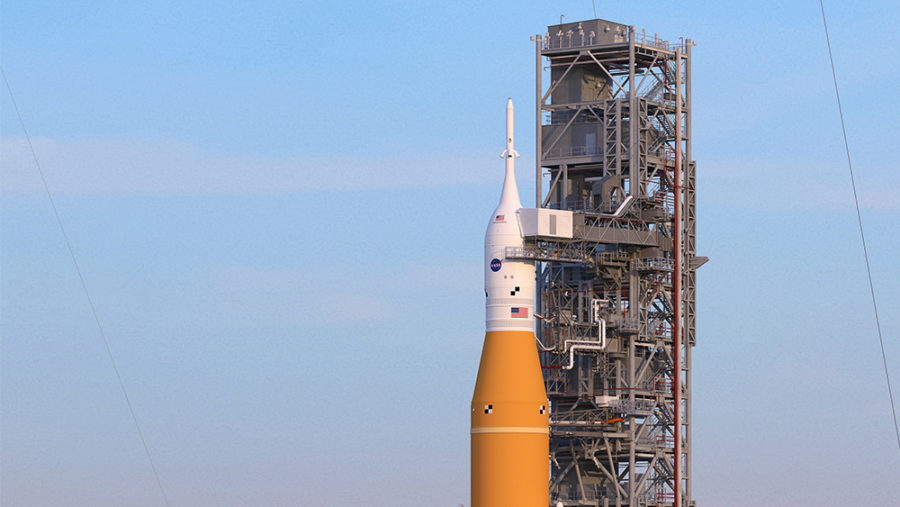New Developments for NASA’s SLS Rocket
Vice-President Mike Pence announced recently that he wanted NASA to land astronauts on the moon in five years, after the White House cut funding for the SLS rocket
The SLS, or Space Launch System, is derived from the Ares-V rocket which was part of the cancelled Constellation program. The Ares-V and Ares-1 were designed as part of the Constellation program to return NASA to the moon following the end of the Space Shuttle program. Like the SLS, the Ares-1 and Ares-V rockets were derived from Space Shuttle hardware.
The Constellation program was plagued with design and funding issues. The Ares-1 consisted of a Space Shuttle solid rocket booster as a first stage and with a second stage powered by an Aerojet Rocketdyne J-2X engine. Only a test flight of the Ares-1 called the Ares-1X got off the ground. The test flight launched on Oct. 28, 2009 and was the last flight to date to launch from Launch Complex-39B at Kennedy Space Center in Florida.
Since the start of SLS development, seven years ago, around $17 billion has been spent. The current amount spent is more than the original $10.6 billion which was projected when the SLS program started in 2011. The SLS was meant to be produced in different versions including the original block 1 version, a crewed block 1B, a cargo block 1B, and then a block 2. The SLS was designed to be similar in height to the legendary Saturn V rocket. However, the 2019 budget request by the White House limits the SLS to simply the Block 1 variant.
The main purpose of the SLS from the start was to send the Orion crew capsule to the moon. The first scheduled test of the SLS, Exploration Mission-1 (EM-1) was originally planned to take place in 2017, but that date has been pushed back to 2020. NASA has admitted that the 2020 launch date will most likely be pushed back due to current technical issues and budget overruns. The plan for EM-1 is for Orion to spend three weeks around the moon while testing critical systems.
The Orion crew capsule, or officially called the “Orion Multi-Purpose Crew Vehicle,” is an Apollo-style capsule (but larger) which is designed for deep space travel. To support Orion in space, the European Service Module will provide solar power, propulsion and critical life support for Orion and its human cargo.


Orion first flew on Dec. 5, 2014 during the Exploration Flight Test-1 (EFT-1) mission. EFT-1 consisted of a launch on a Delta V heavy rocket from SLC-37B at Cape Canaveral Air Force Station in Florida. The spacecraft flew a total of two orbits with the second consisting of a height apoapsis to test intense heating conditions during reentry.
At Kennedy Space Center, there has been significant progress modifying and updating current NASA facilities from the Space Shuttle-era to the new demands of the Commercial Crew Program and the delayed SLS. The NASA Crew Quarters (where astronauts stay prior to launch) and the Apollo and Shuttle-era Firing Rooms (where the launch is controlled) have been updated for both programs. Launch Complex-39A (LC-39A) has been leased to SpaceX and the pad has been significantly modified for both Falcon Heavy and Falcon 9 operations. The SLS will use Launch Complex-39B (LC-39B) for launches. Both LC-39A and LC-39B are nearly identical. The Shuttle-era Rotating Service Structure and Fixed Service Structure which helped prepare the Space Shuttles for launch were torn down.
During a senate committee hearing, NASA administrator Jim Bridenstine admitted that NASA was facing challenges in order to get all the space hardware ready for EM-1 in 2020. One proposal to fix the EM-1 deadline issue was to use commercial launch vehicles for the mission. However, the only possible heavy-lift rockets capable of the mission would be United Launch Alliance’s (ULA) Delta IV heavy rocket and SpaceX’s Falcon Heavy rocket. “The challenge is we don’t have a rocket right now that can launch Orion and the European Service Module around the Moon,” said Bridenstine according to the verge. One of the two rockets could hypothetically launch Orion and the service module to Earth orbit but not Lunar orbit.
To commercially launch Orion and the service module to the moon, EM-1 would require two launches and the Falcon Heavy would have to fly in an expendable configuration. Using either rocket, one launch would hypothetically launch Orion and the service module and another launch would lift the Interim Cryogenic Propulsion stage (ICPS) and dock with Orion. Then, the ICPS would fire it’s engine to take the Orion to the moon.
Using SLS for EM-1 would consist of a launch from LC-39B using the SLS’s two Solid Rocket Boosters (SRBs) and four of its Aerojet Rocketdyne RS-25 engines on the first stage to lift Orion and the service module to Earth orbit. Then the ICPS would separate from the first stage and perform a burn to send Orion to the moon.
However, using Delta IV or Falcon Heavy for Orion would require major launch pad and overall hardware upgrades which would take time. While possible, NASA would rather launch EM-1 on SLS instead of a commercial vehicle. But, NASA will consider its options to whether stay with SLS for EM-1 or go commercial. However, even the consideration of using commercial launch vehicles has served was a wakeup call for other NASA facilities and contractors including Boeing.
In addition, Vice-President Mike Pence recently called upon NASA to shift the planned 2028 moon landing goal forward to 2024 which would demand a drastic acceleration of production. Some critics have tied Pence’s goal to other former administrations which have laid out similar, but unsuccessful goals to evoke President John F. Kennedy’s famous goal to land men on the moon before the end of the 1960’s. However, it is certain NASA will attempt to accelerate SLS production.


